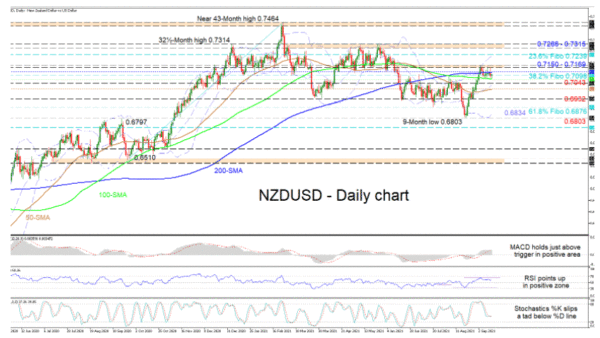NZDUSD is creeping sideways along the 0.7100 level, which happens to be surrounded by the 100- and 200-day simple moving averages (SMAs) at 0.7070 and 0.7120 respectively, after its latest rally ran out of steam. Judging from the SMAs, they are mostly promoting a neutral price development.
The short-term oscillators appear fairly flat and are signalling weak and mixed signals in directional momentum. The MACD has flattened towards its red trigger line in the positive area, while the RSI is trying to improve in bullish territory. The stochastic oscillator is static with its %K line marginally below its %D line, endorsing no clear price direction in the pair for now.
In a positive scenario, preliminary upside obstructions could come from the 200-day SMA at 0.7120 ahead of the resistance band of 0.7150-0.7169. Piloting higher, the upper Bollinger band coupled with the 0.7239 level, being the 23.6% Fibonacci retracement level of the up leg from 0.6510-0.7464, could delay the test of the 0.7286-0.7315 near-term ceiling, an area involving peaks from early March, April and May.
Alternatively, sellers may struggle to break below the immediate 38.2% Fibo of 0.7098 and the nearby 100-day SMA at 0.7070. However, should this play out, a neighbouring zone of support could develop between 0.7043 until the 50-day SMA at 0.7003, which also encapsulates the mid-Bollinger band. Declining further, the price may meet the 0.6932 low before targeting the 61.8% Fibo of 0.6876. From here, if sellers remain in the driving seat, the lower Bollinger band at 0.6834 may come into focus prior to the key 9-month trough of 0.6803.
Summarizing, NZDUSD’s directional forces seem to have temporarily dried up as the price is stuck between the 100- and 200-day SMAs. Nevertheless, a break above the 0.7150-0.7169 barrier or beneath the 50-day SMA at 0.7003 could produce a new price course.














